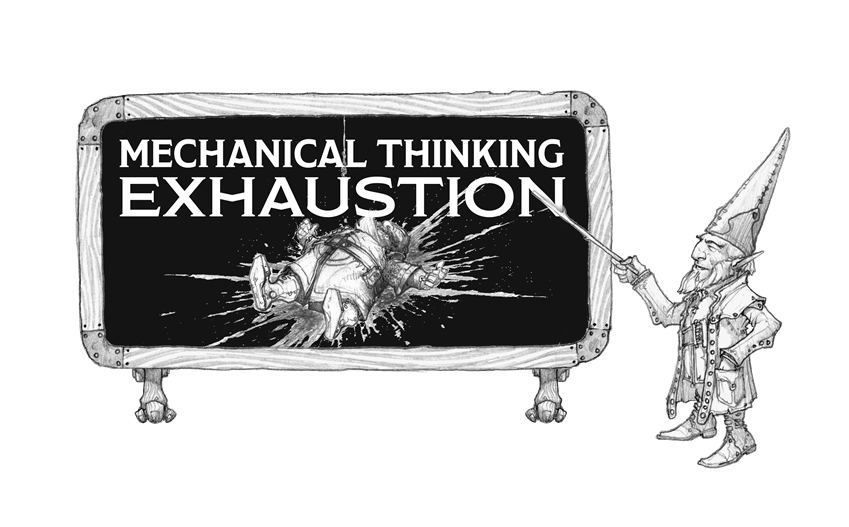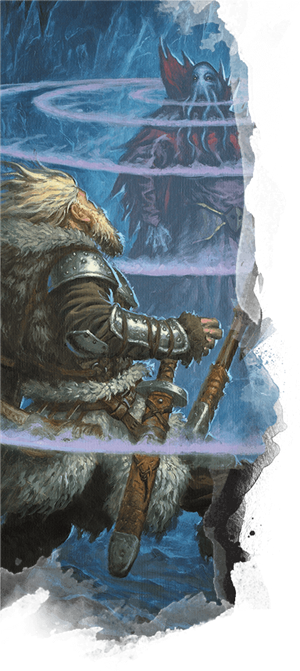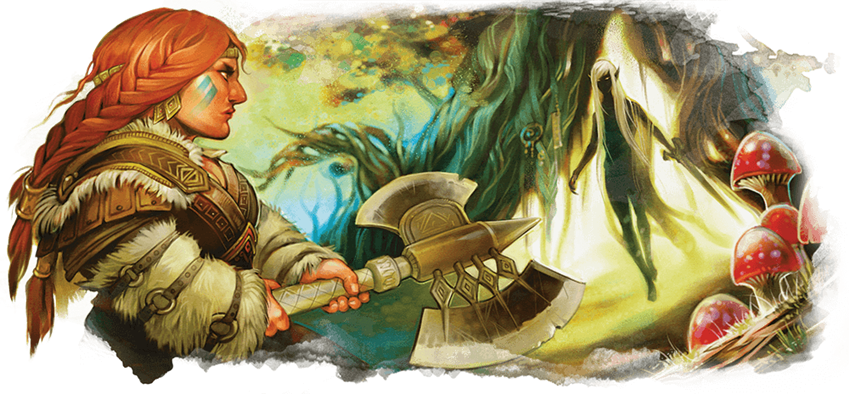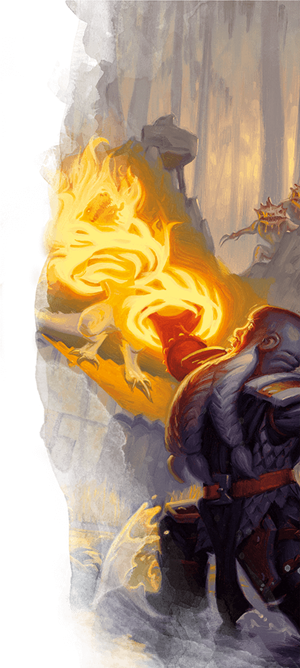Mechanical Thinking is a series that presents new houserules that you can add to your home D&D games, and then interrogates the underlying mechanics, examines what problems the rule solves, and identifies what the rule can do to improve your game. Then, once all is said and done, join me and other readers in the comments for a discussion about the proposed rule. Just remember that all rules have their place, and while they might not fit your table, they might be perfect for another gaming group.
If you have a mind for mechanics or for the process of game design, or if you want hone the mechanical side of your RPG knowledge, this series is for you!

Exhaustion
Exhaustion is a six-step stamina counter unique to fifth edition Dungeons & Dragons that tracks a creature’s physical state from peak condition to death. Unlike hit points, which increase as a character gains levels, exhaustion always remains the same. Likewise, every point of exhaustion a creature gains imposes a cumulative and debilitating effect, ranging from unpleasant-but-minor disadvantage on ability checks at a single point of exhaustion, to complete immobility at five points, to instant death at six points.
Exhaustion’s “death spiral” effect sometimes feels at odds with D&D’s heroic nature, which is best exemplified by hit points—a health tracker that allows a character with only a single remaining hit point to fight just as effectively as a character at full hit points. For that reason, effects that impose exhaustion are mercifully rare in D&D’s rules and adventures—and this scarcity is merciful, as there are precious few ways of recovering from exhaustion. Nevertheless, if you want to add a bit of grit to your D&D game, consider expanding the role of exhaustion:
Exhaustion as Damage
 If you want to make combat more ruthless and visceral, try removing the abstract concept of hit points from your D&D and replacing it with an exhaustion track. This method is similar to, but distinct from, a mechanic introduced in the Star Wars Saga Edition roleplaying game, published by Wizards of the Coast in 2000 and revised in 2002. This mechanic was known as the Condition Track. In addition to damage (which drained a creature’s D&D-style hit points), Star Wars Saga Edition included effects that pushed their target down the Condition Track. Every time a creature advanced down the Condition Track, it suffered mounting cumulative penalties, ultimately resulting in unconsciousness. As was typical of the third edition D&D and the d20 System, these condition penalties were granular penalties to rolls; a character would advance from a –1 penalty to attack rolls, ability checks, and skill checks to a –2, a –5, and so forth.
If you want to make combat more ruthless and visceral, try removing the abstract concept of hit points from your D&D and replacing it with an exhaustion track. This method is similar to, but distinct from, a mechanic introduced in the Star Wars Saga Edition roleplaying game, published by Wizards of the Coast in 2000 and revised in 2002. This mechanic was known as the Condition Track. In addition to damage (which drained a creature’s D&D-style hit points), Star Wars Saga Edition included effects that pushed their target down the Condition Track. Every time a creature advanced down the Condition Track, it suffered mounting cumulative penalties, ultimately resulting in unconsciousness. As was typical of the third edition D&D and the d20 System, these condition penalties were granular penalties to rolls; a character would advance from a –1 penalty to attack rolls, ability checks, and skill checks to a –2, a –5, and so forth.
Exhaustion in fifth edition bears some similarities to Star Wars-style conditions, but by making the penalties of exhaustion less granular, fifth edition actually made exhaustion more debilitating. Being able to move only half speed is a huge deal for only two points of exhaustion, and disadvantage on attack rolls at three points is massive, but to have your hit point maximum halved at four points? Fifth edition exhaustion doesn’t play around. Notably, a creature’s condition could be much more easily restored than D&D exhaustion, which can only be recovered point-by-point by completing a long rest, being soothed by greater restoration, or by consuming a rare potion.
Replacing Hit Points with an Exhaustion Track
You can adapt this idea to D&D by removing hit points entirely, and giving each class their own exhaustion track. A character’s exhaustion track is determined by the size of your class’s hit die, plus your Constitution modifier. For instance, a wizard or a sorcerer has a 6-step exhaustion track, because the wizard and sorcerer classes have a d6 hit die. Likewise, a fighter, paladin, or ranger has a 10-step exhaustion track because those classes have a d10 hit die. Finally, your character’s exhaustion track is extended by a number equal to your Constitution modifier; if your character’s Constitution modifier is negative, your track is reduced by that number of steps.
Whenever you gain a level, your exhaustion track increases by one.
Also, since the fourth step of the exhaustion track in the core rules is "hit point maximum halved," this step will have to be replaced. Instead, creatures that have reached this step can only take an action or a bonus action on their turn, not both. Additionally, they can't take reactions.
Creatures with Exhaustion Tracks Longer or Shorter than Six Steps
Under this system, most creatures have an exhaustion track more than six-steps long. For instance, a wizard with a +1 Constitution modifier has a 7-step exhaustion track. However, since there are only six steps of exhaustion in D&D, every step of your track your character has above 6 is “safe.” Gaining a point of exhaustion has no effect until you enter the final six steps of your exhaustion track.
For example, a rogue (d8 hit die) and a +2 Constitution modifier has an exhaustion track that looks like this:
|
Level of Exhaustion |
Effect |
|
1 |
— |
|
2 |
— |
|
3 |
— |
|
4 |
— |
|
5 |
Disadvantage on ability checks |
|
6 |
Speed halved |
|
7 |
Disadvantage on attack rolls and saving throws |
|
8 |
Can only take an action or a bonus action on a turn, and can't take reactions |
|
9 |
Speed Reduced to 0 |
|
10 |
Death |
Similarly, if your exhaustion track is shorter than six steps, you suffer the effects of exhaustion in order (starting with disadvantage on ability checks at one point of exhaustion) but die when you reach the end of your exhaustion track. For example, a character with a 5-step exhaustion track dies after gaining five points of exhaustion, rather than having its speed reduced to 0 first.

Gaining Exhaustion when Taking Damage
In addition to the usual ways a creature become exhausted (such as through strenuous travel and dangerous environments), a creature gains a point of exhaustion whenever it takes damage. This damage could come from any source, such as an attack, a spell, or an environmental effect. Especially powerful attacks, environmental effects, and spells could cause more than 1 point of exhaustion, at the DM’s discretion. If a single attack or effect deals multiple types of damage, such as a flying snake's bite dealing both piercing and poison damage, this attack still only inflicts 1 point of exhaustion.
Healing
Whenever an effect would cause a creature to regain any number of hit points, it instead loses 1 point of exhaustion. If the healing effect is a spell that only targets a single creature, the spell causes its target to lose a point of exhaustion per level of the spell. Healing spells that target multiple creatures and restore large amounts of hit points, like mass cure wounds and mass heal are left to the DM’s discretion.
Also, lesser restoration now causes its target to lose 1 point of exhaustion in addition to its other effects. Lastly, greater restoration now causes the target to lose 2 points of exhaustion in addition to its other effects. A potion of healing causes the creature who drinks it to lose 1 point of exhaustion, a potion of greater healing restores 2 points of exhaustion, and so forth.
Finally, a creature can lose 1 point of exhaustion by spending a hit die when it completes a short rest. Restoring exhaustion further in the same short rest costs one additional hit die per point cured; for instance, curing three points of exhaustion in a single rest costs six hit dice, one hit die for the first, two for the second, and three for the third.
Monsters
 Instead of having hit points, a monster has a number of exhaustion steps equal to its number of hit dice. Monsters exhaustion tracks work similarly to characters’ exhaustion tracks; if this number is less than six, the monster suffers the effects of exhaustion as normal, but dies after it gains points of exhaustion equal to its number of hit dice.
Instead of having hit points, a monster has a number of exhaustion steps equal to its number of hit dice. Monsters exhaustion tracks work similarly to characters’ exhaustion tracks; if this number is less than six, the monster suffers the effects of exhaustion as normal, but dies after it gains points of exhaustion equal to its number of hit dice.
Dying
When a creature reaches the end of its exhaustion track, it dies. Unlike in the core fifth edition rules, no creatures make death saving throws. If you want your game to be more forgiving, consider allowing player characters and important NPCs to start dying when they reach the end of their exhaustion track instead of perishing outright. Dying creatures make death saves as normal.
Points of Stress in this House Rule
This house rule isn’t perfect. Fifth edition Dungeons & Dragons was designed with hit points in mind, and simplifying hit points into an exhaustion track has some serious drawbacks, in exchange for making your games less lethal in earlier levels and potentially more lethal at higher levels. It makes hordes of weak creatures incredibly dangerous, and creatures with many attacks (such as a marilith or a carrion crawler disproportionately powerful, since all attacks have the same effective power under this system, regardless of whether they would have dealt 10 damage or 100 in a hit point-based system.
Because of the way the power of certain spells and features fluctuate with this rule in place, Dungeon Masters may have to make ad hoc adjudications when translating the power of area-of-effect spells from hit point damage to exhaustion damage. As a simple house rule, these sort of adjudications are fine. If this system were translated into a full and exhaustive D&D-like spinoff game, a full rework of many monsters, spells, and features would be in order to suit this new mechanical framework.
Also, no exhaustion-as-damage houserule would be complete without addressing the “death spiral” effect, in which characters become less effect and less likely to succeed in a fight as the fight goes on. This effect is cushioned somewhat by allowing hardy characters to take multiple hits before suffering from exhaustion effects, but it is nevertheless still present. The death spiral effect on monsters also adds to the Dungeon Master’s mental load, as the DM now has to keep track of all the effects clinging onto their monsters throughout the course of an encounter and beyond.
What do you think of this new house rule? Would you use it in your game? What would you change? Let us know in the comments below!
 James Haeck is the lead writer for D&D Beyond, the co-author of Waterdeep: Dragon Heist and the Critical Role Tal'Dorei Campaign Setting, the DM of Worlds Apart, and a freelance writer for Wizards of the Coast, the D&D Adventurers League, and Kobold Press. He lives in Seattle, Washington with his partner Hannah and their animal companions Mei and Marzipan. You can find him wasting time on Twitter at @jamesjhaeck.
James Haeck is the lead writer for D&D Beyond, the co-author of Waterdeep: Dragon Heist and the Critical Role Tal'Dorei Campaign Setting, the DM of Worlds Apart, and a freelance writer for Wizards of the Coast, the D&D Adventurers League, and Kobold Press. He lives in Seattle, Washington with his partner Hannah and their animal companions Mei and Marzipan. You can find him wasting time on Twitter at @jamesjhaeck.








-
View User Profile
-
Send Message
Posted May 30, 2019This could be a great way to speed up the game and make it more heroic in fights against large monsters by not waiting for damage dice to be tallied while also preventing insta-kills against squishy players. You can get the game down to decisions and only d20s, which I like.
-
View User Profile
-
Send Message
Posted May 30, 2019In my campaigns the way I weave Exhaustion into the game is by making is so that anytime a character falls below 0. When they come back (if they come back), they take one point of exhaustion as a result. I've never liked the "edge healing" mechanic in 5e where you go down and are back and fully functional after a Healing Word. This way there is a consequence to falling during battle. You've suffered trauma and it starts to show. Which basically means if you go down in combat enough... you're dead dead.
The one sub-class that really is disadvantaged by this is the Grave Cleric. Who basically specialize in "edge healing". But I'm not DM'ing any so no worries for me.
The behavioral change amongst players since instituting this is that they are now proactively healing more often, investing in healing potions, etc. Greater Restoration is being memorized and used more often as well (to help remove accumulated exhaustion points).
Also, it's added a dangerous edge when they have a marathon of encounters in the same day. Even those classes that need only a short-rest to regain their full abilities are now affected potentially.
-
View User Profile
-
Send Message
Posted May 30, 2019How would this work when using a Blood Hunter's rite, which lowers its hit point maximum?
-
View User Profile
-
Send Message
Posted May 30, 2019I thought this same thing. That’s a lot to keep track of but if your players are willing, I think it would add a new dimension to battles.
-
View User Profile
-
Send Message
Posted May 30, 2019We use this variant in our campaign and it's a good compromise - gives going unconscious some consequences but also isn't too lethal.
-
View User Profile
-
Send Message
Posted May 30, 2019Monk's Flurry of Blows is looking really good here.
-
View User Profile
-
Send Message
Posted May 30, 2019Very interesting! I could see running a one-shot with this rule, it seems like it could have a very fresh flavour.
The conundrum of attack value is important here, though. Hmm, what if for every 10 points of damage (or whatever value you choose) the attack deals, it gives you 1 exhaustion (to a minimum of 1). So a hit will always reduce by one, but those big singular attacks can deal a lot more, which keeps Sorcerers and Dragons happy. ;)
-
View User Profile
-
Send Message
Posted May 30, 2019Perhaps sources of bonus damage could be counted separately. Thus a sneak attack would do additional exhaustion damage; say, one per tier of sneak attack progression.
Or perhaps you reserve the rule for particular uses. It definitely changes the feel of the game. I know it makes Magic Missile extremely potent.
-
View User Profile
-
Send Message
Posted May 30, 2019That’s what I was thinking immediately when I read the article title.
-
View User Profile
-
Send Message
Posted May 30, 2019Missing end parenthesis here:
There should be a closing paren after "carrion crawler".
-
View User Profile
-
Send Message
Posted May 30, 2019I'm totally house ruling that 0 HP = +1 Exhaustion. Fantastic idea.
I might also add that receiving a crit or damage more than 25% of your max HP = +1 exhaustion. One of my biggest problems with travel encounters and wandering monsters is that there is no real consequence to them. It's either a TPK or the heroes win and recover everything. At least in this scenario, there may be some semi-persistent cost to it.
-
View User Profile
-
Send Message
Posted May 30, 2019I'll give you one that works similarly, is slightly more complex, but doesn't destroy the damage ratio of everything in the entire game:
HP is split into 2 stats. Health and Stamina.
Health is equal to Constitution Score plus Level. Stamina is based on class HP plus Con mod (minus 1) per level.
Then you add a Fatigue condition track that works similar to Exhaustion but is short term, a short rest recovers all fatigue. Anything that adds a level of fatigue can be prevented by spending a stamina point. Damage targets your hp but you can choose to take fatigue levels to prevent it (and thus spend stamina to prevent the fatigue)... In effect this allows you to essentially spend stamina to soak damage, or spend fatigue to in an emergency. Dropping to 0 hp causes you to hit fatigue 6.
If you hit full fatigue you gain a level of exhaustion, instead of dying. And the one level that halves HP instead only lets you take an action or bonus action on your turn, not both. Otherwise same penalties as exhaustion at each fatigue level.
Oh and... you can spend an action on your turn to spend a HD to 'catch your breath' and recover Stamina. And if you wanna make healing actual injuries a bigger deal, make spending HD during a rest only heal one Health per HD spent. (to balance that all Stamina is freely recovered)
This also allows you to create and toss in an injured/wounded/bloodied condition for once someone takes actual health damage. Should you like that sort of thing.
-
View User Profile
-
Send Message
Posted May 30, 2019I like this rule but not the article
-
View User Profile
-
Send Message
Posted May 30, 2019I've always found that hitpoints are more of an abstract Idea of a characters resolve and that players and enemies cannot draw blood from an attack until they have reached half health and aquired a "Bloodied" Condition. I encourage other forms of health in games and tossing the whole "stabbed until dead" combat.
-
View User Profile
-
Send Message
Posted May 30, 2019I do really like this use of Levels of Exhaustion. Alternatively, if you feel this makes your players a bit too squishy, you could try adjusting the total by adding your class hit die on top of the 6 levels of exhaustion. This would allow a little more wiggle room for additional LoE lost due to special attacks and critical hits.
So, Barbarians would start with 18 LoE;
Fighters, Pali's, and Rangers with 16 LoE;
Bards, Clerics, Druids, Monks, Rangers,
Rogues, and Warlocks with 14 LoE:
Sorcerers and Wizards with 12 LoE
(each +/- their Constitution modifier).
Of course, this system would also be complicated by multiclassing, but I'm sure adjustments could be made to class HD based on the average.
-
View User Profile
-
Send Message
Posted May 30, 2019Now, this idea I like! I just added that to my OneNote D&D idea folder to use in my next game. I had trouble introducing exhaustion into the one game I DM'd last year although I really enjoy the mechanic. My player's only wanted to "fast travel". As an old AD&D player from the late '70s through the mid-'80s who just got back into the hobby last year, I really miss the Outdoor Survival aspects of the game that my recent group didn't care for. Stuff like resource management, navigating, getting lost, weather and environmental effects (especially in the middle of an encounter), hunting, foraging, camping, keeping watch at night, random encounters and exhaustion. Heck, back in my day we rolled to gather firewood! When they rolled up a Ranger, a Druid, a Nature Cleric, and an Arch-Fey Patroned Warlock I just assumed they were down for some slogging through the Wilderlands of High Fantasy for a session when they traveled from Point A to Point B about one week worth of travel away. I was wrong. Thanks again for the idea!
-
View User Profile
-
Send Message
Posted May 30, 2019I'd actually still keep rolling damage, with every 5 full damage dealt causing 1 Exhaustion Level (minimum 1). So 1-9 damage = 1 Exhaustion Level, 10-14 = 2 levels, 15-20 = 3 levels, etc. Crits can still double damage dice, but 2d4+1 would still only be 1 level, so I'd instead make Crits double Exhaustion levels dealt.
A flat 5 works better than being based on the target's HD size. In addition to being the same for everyone, the math is easier to do on the fly vs 4/6/8/10/12, and it keeps the same scale between classes - a Barbarian is still twice as tough as a Wizard. If you did it by HD size, that Barbarian would be 4x as tough, and take a HUGE amount of damage to drop (144 at level 1 with CON+0, vs 60 if it's flat 5). Additionally, most weapons, given a +2 or +4 modifier, have a chance of rolling 10 damage and doing 2 levels, so rolling is still worthwhile for normal attacks. Even at flat 5, a Wizard can take upwards of 30 damage to kill.
-
View User Profile
-
Send Message
Posted May 30, 2019Keep the hit points and divide them into six segments. When the first segment of hit points is depleted you gain the effect of 1 point of exhaustion. When the second is depleted you gain a second point and so on.
This should solve a lot of the problems with the first idea by James while still giving some extra challenge.
If your looking for a fast based campaign or doing a one shot exhaustion may slow your game down too much,and interfere with the intended flow. But other wise this sounds like a very fun and challenging rule for both beginners and advanced players alike.
Lastly the idea that James had of after droping to 0 hit points taking a point of exhaustion sounds like a great realism rule that should add a bit of realism to the game and cause the players to be more strategic.
Thank you for the inspiration James Haeck
-
View User Profile
-
Send Message
Posted May 30, 2019My inclination would be for exhaustion inflicted by big hits: any hit that deals damage equal to or exceeding the target's Con score (plus Proficiency Bonus if you want some level scaling) inflicts a level of exhaustion.
-
View User Profile
-
Send Message
Posted May 30, 2019They mentioned in the article that if an attack did multiple types of damage, it still only counted as one.